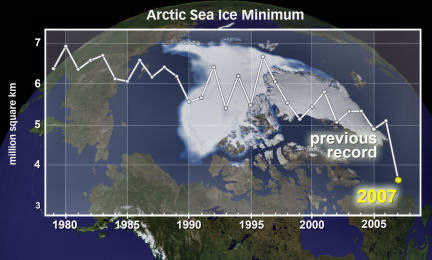Arctic melt
There is less ice than ever recorded in the Arctic Ocean, and scientists are concerned.
Share this:
- Share via email (Opens in new window) Email
- Click to share on Facebook (Opens in new window) Facebook
- Click to share on X (Opens in new window) X
- Click to share on Pinterest (Opens in new window) Pinterest
- Click to share on Reddit (Opens in new window) Reddit
- Share to Google Classroom (Opens in new window) Google Classroom
- Click to print (Opens in new window) Print
By Emily Sohn
Earth’s North and South Poles are famous for being cold and icy. Last year, however, the amount of ice in the Arctic Ocean fell to a record low.
Normally, ice builds in Arctic waters around the North Pole each winter and shrinks during the summer. But for many years, the amount of ice left by the end of summer has been declining.
 |
|
The map in the background shows last year’s record-low ice cover in the Arctic. The graph shows how Arctic ice cover has declined over the years.
|
| NASA |
Since 1979, each decade has seen an 11.4 percent drop in end-of-summer ice cover. Between 1981 and 2000, ice in the Arctic lost 22 percent of its thickness—becoming 1.13 meters (3.7 feet) thinner.
Last summer, Arctic sea ice reached its skimpiest levels yet. By the end of summer 2007, the ice had shrunk to cover just 4.2 million square kilometers (1.6 million square miles). That’s 38 percent less area than the average cover at that time of year. And it’s a whopping 23 percent below the previous record low, which was set just 2 years ago. This continuing trend has scientists concerned.
There may be several reasons for the ice melt, says Jinlun Zhang, an oceanographer at the University of Washington in Seattle. Unusually strong winds blew through the Arctic last summer. The winds pushed much of the ice out of the central Arctic, leaving a large area of thin ice and open water.
Scientists also suspect (but haven’t yet documented) that fewer clouds cover the Arctic now than in the past. Clearer skies allow more sunlight to reach the ocean. The extra heat warms both the water and the atmosphere.
Water in the area is definitely getting warmer. In parts of the Arctic Ocean last year, surface temperatures were 3.5° Celsius warmer than average and 1.5°C warmer than the previous record high.
With both air and water getting warmer, the ice is melting from both above and below. In some parts of the Beaufort Sea, north of Alaska and western Canada, ice that measured 3.3 m (11 feet) thick at the beginning of the summer measured just 50 centimeters (20 inches) by season’s end.
The new measurements suggest that melting is far more severe than scientists have seen by just looking at ice cover from above, says Donald K. Perovich, a geophysicist at the U.S. Army Cold Regions Research and Engineering Laboratory in Hanover, N.H.
“There’s a lot less ice there than we think,” he says. “And the farther we go down this path, the harder it is to get back.”
As more ice melts each summer, it takes longer for seawater to freeze each winter. Some scientists fear that the Arctic is stuck in a warming trend from which it may never recover.
Going Deeper:
Perkins, Sid. 2007. Portrait of a meltdown: Many factors led to 2007’s record low in Arctic sea ice. Science News 172(Dec. 22 & 29):387. Available at http://www.sciencenews.org/articles/20071222/fob2.asp .
Sohn, Emily. 2007. Polar bears in trouble. Science News for Kids (July 25). Available at http://www.sciencenewsforkids.org/articles/20070725/Note3.asp .







